TASTING AND TIDYING, OR NOT
Fruit Heaven
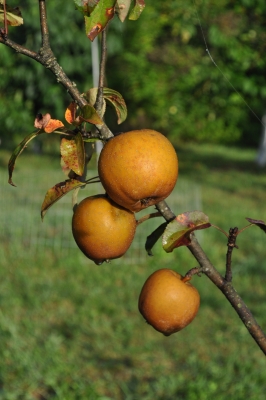
Hudson’s Golden Gem apple
I remember a few years ago of having a most fruitful — and I mean this very literally — experience visiting one of the USDA’s germplasm repositories. “Germplasm repository” doesn’t sound like the kind of place anyone would want to be, but these USDA repositories are, in fact, sunny, colorful places, often redolent with enticing aromas. In the case of the one I visited, the aroma was of ripening apples.
Germplasm is the stuff that gives rise to an organism, and the USDA has set up repositories around the country to house various kinds of plants. Each repository is situated where a particular group of plants grows well. So Davis, California is home to the repository for figs, pomegranates, and Asian persimmons; Corvallis, Oregon is the repository for pears, gooseberries, and mint; and Geneva, New York, where I visited, houses the collections of apples and American-type grapes. (My own gooseberry collection helped build the gooseberry collection at Corvallis about 30 years ago.)
Taking into account seed collections and other, related work, these repositories maintain over 20,000 accessions of plants representing over 300 species. Germplasm from these collections is available to scientist and other interested citizens, which is how I obtained grafting wood to make most of the rare varieties of apples and pears that I grow.
So there I was — a fruitophile — standing with clipboard in hand and camera in pocket in in a field of apple trees, each one a different variety. My mission: Photograph and collect 3 to 4 samples of a couple of dozen varieties. What sweet labor! (I had previously contacted the repository staff and received permission).
Up and down the rows I went, photographing, collecting, and, of course, tasting. Apples have been cultivated for so long and are so popular a fruit that it’s no wonder that such great variation exists in the fruits’ appearances and flavors. Flavors include anise-flavored Ellison’s Orange, sweet Mollie’s Delicious, spicy-tart Cox’s Orange Pippin, and everything in between and beyond. The range in color goes from gray-brown Pomme Grise to cheery red-splashed yellow King of the Pippin. And then there are variations in fruit size and shape and, less obvious, characteristics such as pest resistance, productivity, and cold tolerance.
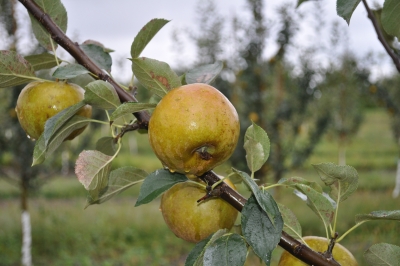
Ashmead’s Kernel apple
Most important, to me, is flavor. I should have brought a palate cleanser because after a while all the varieties were beginning to taste like . . . well . . . apples. Nonetheless, two varieties that I did not grow did stand out for flavor; I ordered grafting wood of Hudson’s Golden Gem and Pitmaston Pineapple to graft onto trunks of my Ingrid Marie trees once I lop their tops off.
After the apples, there were grapes to photograph and sample.
Tidy Not
Boy, would I love to tidy things up with some pruning now. The Golden Celebration rose bush would look nicer in coming months with those couple of tall, gawky stems cut off or back.
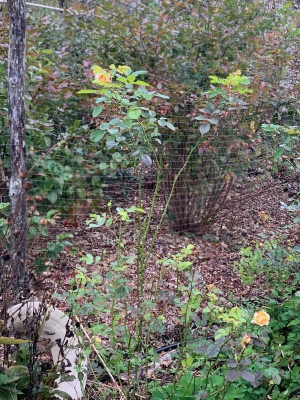
Grape and hardy kiwi stems are reaching out all over the place, grabbing onto each other and anything else they can wrap around.
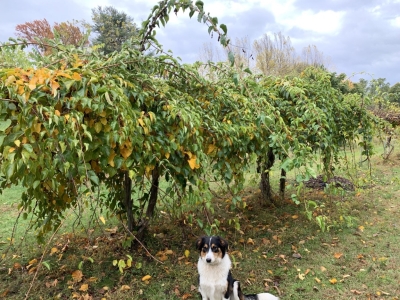
The pear trees have a nice spreading form — except for watersprouts shooting vigorously skyward from the uppersides of some of the spreading branches. How nice it would be to cut these plants back now rather than in spring.
But I’m going to restrain myself from doing any pruning. As stated in The Pruning Book (by me!), “Although immediate regrowth rarely occurs after late summer or autumn pruning, cells right at the cut are stirred into activity to close off the wound. Active cells are liable to be injured by cold weather, which is a reason to avoid pruning in late summer or autumn except in climates with mild winters or with plants that are very hardy to cold.”
Gooseberries and currants are super cold hardy plants and begin growth relatively early in spring. All of which makes a good case for pruning those plants now.
And a Case for Not Tidying
Rather than prune, a good place to re-channel that “tidy everything up” urge is in the vegetable and flower garden.
Cleaning up is one way to lessen pest problems next year. As I pulled out spent bush bean plants, I gingerly placed them into the garden cart and, from there, onto the compost pile, trying not to disturb the resident bean beetles. Those bean beetles had hoped to spend the winter on site, to emerge next spring and lay eggs on next year’s bean plants. I’m hoping to “cook” as many of them as possible in the compost pile.
Tomato plants are looking a bit ragged even though they’re still bearing some tomatoes for fresh eating. Gathering up all stems, leaves, and old fruits and composting them reduces the inoculum load of diseases such as early blight and septoria leaf spot. Left in place, they would spend winter out in the garden ready to infect next year’s plants. It’s not a question of eradication, which isn’t possible, but of balance.
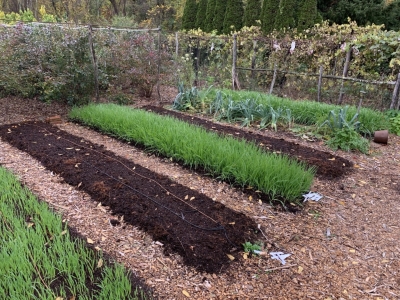
Cutting down old peony stems and composting them takes inoculum for next years botrytis disease off-site. Left to infect plants next spring, botrytis could keep peony flower buds from unraveling.
As Charles Dudley Warner wrote over a hundred years ago (in My Summer in the Garden, which I highly recommend and is much more than a gardening book), “the closing scenes are not necessarily funereal . . . a garden . . . goes into winter-quarters . . . neat and trim . . . so that its last days shall not present a scene of melancholy ruin and decay.”

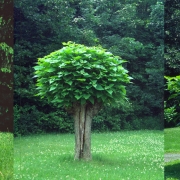

Very timely post. My compost pile does not run very hot, warm, but not hot. Over the past few years I have been taking spent tomato plants to our landfill rather than composting them in hopes of controlling disease. Any thoughts on this? Thank you.
I would — and have — composted old tomato vines, and everything else. Just let the compost thoroughly ripen before using it.
Thanks Lee. I garden in the Finger Lakes area so my weather is similar to yours…except for the snow of course!
Hi Lee,
Thanks for the inspiration to do garden “tidying” this Saturday, before the rain on Sunday I have about 30 different varieties of apple trees in our homestead apple orchard and I certainly agree with you about the Hudson Golden Gem. Definitely one of my top 5 for fresh eating. Saturday will be garlic planting as well.
best regards
Jack
Zone 5A, Langdon, New Hampshire
Hi Lee, how do you go about requesting cuttings from the USDA germ plasm repository? I requested some cuttings of figs and mulberries but got an email denying my request. Do you have any advice?
Either come up with a good reason why you should have them according to their criteria. Or else order plants from a nursery.
Lee, Like you, Hudson Golden Gem is one of my favorite apples but I’ve been disappointed with the yield of mine. It’s 6 years old and yields no more than my young Goldrush apple which first fruited in 2021. I also have a Keepsake apple same age as HGG but is high yielding. My HGG always has a heavy June drop compared to my other trees. Is that your experience? Can I do anything to boost the yield?
My HGG doesn’t get excessive June drop. It’s main problem is splitting of the fruit. Your heavy June drop could be from poor pollination or a weakly tree that can’t support too many fruits. Or something else. I don’t think its pollination requirement are very finicky. Try hand pollinating with a couple of different varieties.